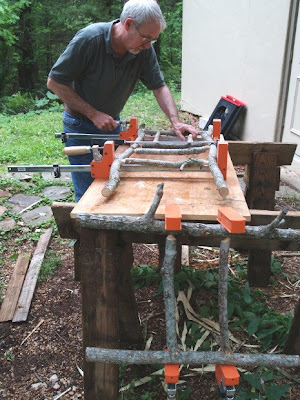 In case you are wondering how to make twig furniture with no bark, here's how: Cut it in the spring then peel it before the wood gets a chance to dry. While the bark is wet and flexible, it comes right off. Well, not exactly right off. You still have to work at it. I use a razor knife to get under the bark and then grab it with my thumbs and pull. Depending on your state of mind, it takes forever, or goes amazingly fast. Being patient and in the moment is a skill, and not one to be taken lightly. It takes practice and for those who live their lives continuously distracted and entertained, being patiently in the moment is excruciating, but it can be learned. It can make the difference between surviving or being road-kill, and it can make the difference between living a life of joy or suffering.
In case you are wondering how to make twig furniture with no bark, here's how: Cut it in the spring then peel it before the wood gets a chance to dry. While the bark is wet and flexible, it comes right off. Well, not exactly right off. You still have to work at it. I use a razor knife to get under the bark and then grab it with my thumbs and pull. Depending on your state of mind, it takes forever, or goes amazingly fast. Being patient and in the moment is a skill, and not one to be taken lightly. It takes practice and for those who live their lives continuously distracted and entertained, being patiently in the moment is excruciating, but it can be learned. It can make the difference between surviving or being road-kill, and it can make the difference between living a life of joy or suffering.If you don't plan to peel your twigs, cut them in the winter when the cambium layer is dormant. If you cut it in the spring or summer the bark may loosen and come off piecemeal from the finished work.
Paying attention to the timing of things can be essential. In case you have lived indoors too long, I would inform you that the seasons do matter.
The wood shown above is elm, cut green yesterday. I will dry it for a while before use. It may split and check, but this is for rustic work in which the wood tells more of its story than my own. Harvesting materials like this does little or no environmental damage. In fact,the forests often benefit from some thinning of trees to reduce competition for nourishment, water, and light. The surface texture of the wood after peeling is amazing. It is so smooth without sanding. Later when the wood is dry and the work is assembled, I'll rub it with a piece of steel wool and apply an oil finish. The photo below shows gluing the front and back assemblies for the rustic chair. Tomorrow I'll add some more stretchers and arms and begin weaving the seat and back.

No comments:
Post a Comment